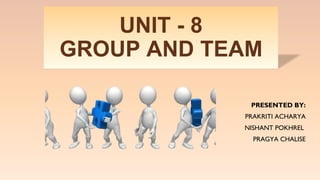
Group
- 1. UNIT - 8 GROUP AND TEAM PRESENTED BY: PRAKRITI ACHARYA NISHANT POKHREL PRAGYA CHALISE
- 2. Today we’ll be discussing about : ❑ Meaning of Group ❑ Characteristics of Group ❑ Reasons for Group Formation ❑ Stages of Group Formation ❑ Types of Group ❑ Differences between Formal and Informal Group
- 3. Group A group can be defined as two or more individuals who come together to achieve particular goal. OR It is a combination of individuals, who have: •Regular contact and interaction •Mutual influence •Common feeling of companionship And all these acts are performed to achieve common set of goals.
- 4. Definitions of Group There are numbers of definitions of groups. Some of them are : ❑ Stephen Robbins A group is defined as two or more individuals, interacting and interdependent, who have come together to achieve particular objectives. ❑ Moorhead Griffin Group is a two or more people who interact with one another such that each person influence and is influenced by the other person. ❑ David H. Smith A group is a set of two or more individuals who are jointly characterized by a network of relevant communications, a shared sense of collective identity and one or more shared dispositions with associated normative strength.
- 6. Characteristics of Group o Collection of two or more people o Common goal or Interest o Interaction and Interdependence o Collective Identity o A Stable Structure
- 7. Reason of group formation 1) Shared interests or goal: People may come together to purpose a commom interest or goal, such as a hobby, sport or work project. 2) Need for support or belonging: Individuals may join a group to feel a sense of belonging or to receive support from others who share similar experience and challenges.
- 8. 3.Social Influence: People may form or join groups because they are influenced by their peers or because they want to 4.Personal Relationships: Groups may form around pre-existing personal relationship, such as family , friends or colleagues. 5. Shared identity or values: Individuals may come together based on shared identity, such as ethically, religion , or political affiliation or shared values and beliefs.
- 9. STAGE OF GROUP FORMATION • Group formation typically involves four stages, which are: • 1. Forming: • In this stage, group members are just starting to get to know each other. They are usually polite and cautious in their interactions as they try to establish their roles in the group and determine the group’s purpose and goals. • 2.Storming : • In this stage, conflicts and differences among group members start to emerge. Members may challenge each other’s opinions and positions, and disagreements may arise regarding the group’s goals and objectives.
- 10. • 3.Norming: • During this stage, the group starts to develop cohesion and establish norms and rules for behaviours. Member may start to compromise and work together to achieve common goals. • 4. Performing: In this final stage, the group is highly productive and works effectively towards its goals. Member trust each other, communicate well and work together efficiently the group has clear sense of purpose and direction and is capable of making decision and solving problems effectively.
- 11. TYPES OF GROUP FORMAL WORK GROUP • COMMAND GROUP • TASK GROUP INFORMAL WORK GROUP • INTEREST GROUP • FRIENDSHIP GROUP
- 12. FORMAL GROUP 1. Predetermined objectives • 2. Well defined responsibility-authority relationship • 3. Formal relations are well planned and created deliberately 4. Formal chain of command 5. Usually stable and rigid organizational structure 6. Lack of consideration of human sentiments
- 13. . COMMAND GROUP 1. Collection of subordinates who report to the same supervisor. 2. Command groups are based on the basic reporting relationships in organizations , 3. They are frequently represented on organizational charts.
- 14. . TASK GROUP .1 Collection of people who come together to accomplish a specific goal. 2. Once the goal has been accomplished, the task force is usually disbanded. 3. Standing committee or task groups are task forces that may be enduring (though members may change) or permanent in nature.
- 15. INFORMAL GROUP 1. No predetermined objectives 2. Run with personal and emotional relationship 3. informal relations are well planned and created knowingly. 4. Does not have formal chain of command 5. Usually unstable and highly flexible organizational structure 6. Fully operated with human sentiments 7. Informal leaders are chosen from the group member.
- 16. FRIENDSHIP GROUP • . Interest group • 1. Collection of people having a common goal or objective (related to their organizational membership) • . 2. Members involve in group to achieve organizational goals by uniting their efforts. • 3. Membership usually limit within the organization for particular purpose. 1. Collection of organizational members who enjoy each other’s company and socialize with each other (often both on and off the job). 2. Members know each other very well and behave good. 3. Membership can be extended outside the organization.